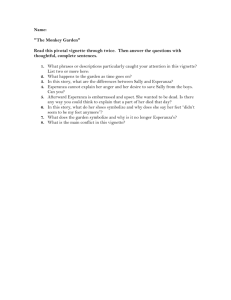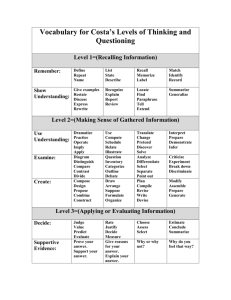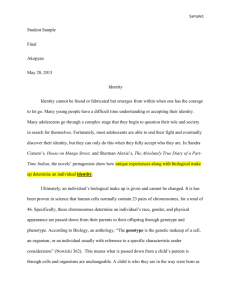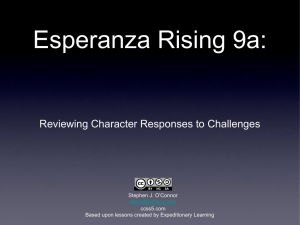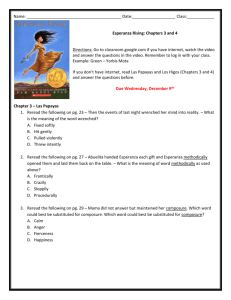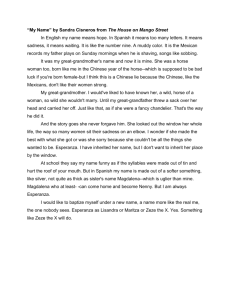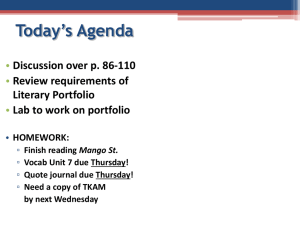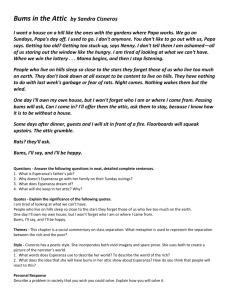Culture Project
advertisement
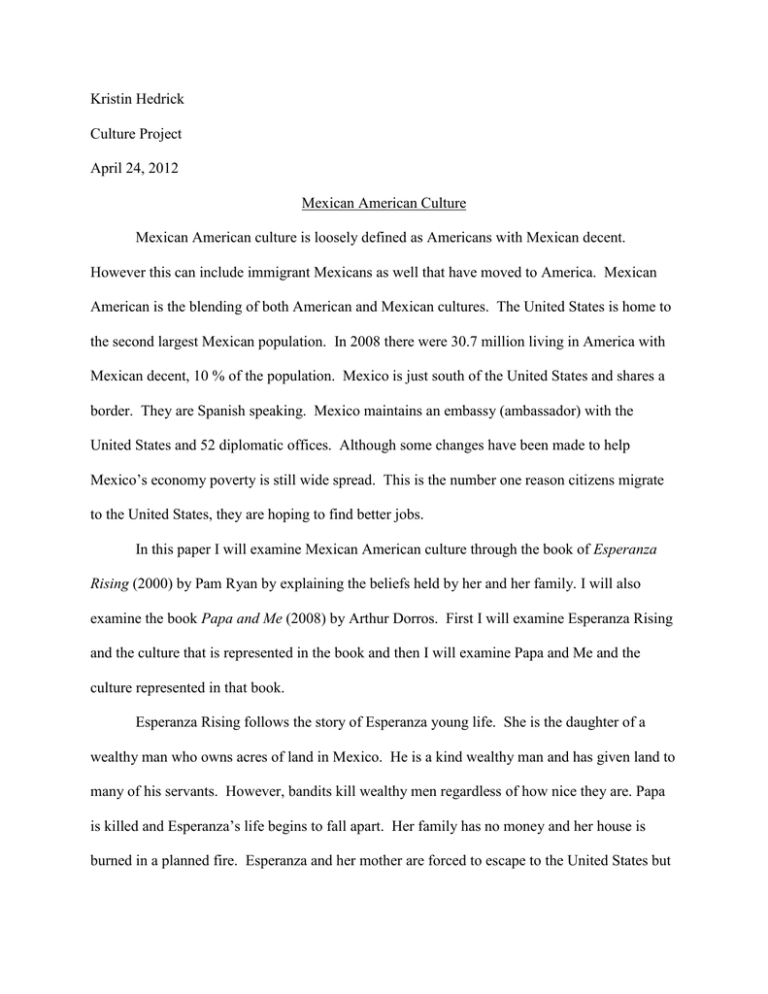
Kristin Hedrick Culture Project April 24, 2012 Mexican American Culture Mexican American culture is loosely defined as Americans with Mexican decent. However this can include immigrant Mexicans as well that have moved to America. Mexican American is the blending of both American and Mexican cultures. The United States is home to the second largest Mexican population. In 2008 there were 30.7 million living in America with Mexican decent, 10 % of the population. Mexico is just south of the United States and shares a border. They are Spanish speaking. Mexico maintains an embassy (ambassador) with the United States and 52 diplomatic offices. Although some changes have been made to help Mexico’s economy poverty is still wide spread. This is the number one reason citizens migrate to the United States, they are hoping to find better jobs. In this paper I will examine Mexican American culture through the book of Esperanza Rising (2000) by Pam Ryan by explaining the beliefs held by her and her family. I will also examine the book Papa and Me (2008) by Arthur Dorros. First I will examine Esperanza Rising and the culture that is represented in the book and then I will examine Papa and Me and the culture represented in that book. Esperanza Rising follows the story of Esperanza young life. She is the daughter of a wealthy man who owns acres of land in Mexico. He is a kind wealthy man and has given land to many of his servants. However, bandits kill wealthy men regardless of how nice they are. Papa is killed and Esperanza’s life begins to fall apart. Her family has no money and her house is burned in a planned fire. Esperanza and her mother are forced to escape to the United States but leave Abuelita (grandmother) behind. They go to work at a camp where Mama gets very sick. Both have a hard time adjusting. Esperanza works to pay for her grandmother to come live with them. Finally Mama gets better and they are all reunited! There are many things I learned about Mexican and American culture through this book. Esperanza Rising really helped me get into the Mexican American way of thinking. Throughout the next paragraphs I explain the many aspects of Mexican American portrayed through the book. These include: connection to nature, importance of celebrating the little things, connection and respect for family members, pride in heritage and self, and the importance of religious ceremonies. Esperanza’s family firmly believes that the earth is alive and that they should live as one with it. From chapter one: “She pressed closer to the ground, until her body was breathing with the earth’s. and with Papa’s. The three hearts beating together (pg3).” Papa is explaining to her the importance of nature and a human’s connection. This is furthered in chapter 2 when the community gathers to cut the first fruit for the harvest. “Esperanza walked back to Papa and handed him the fruit. Papa kissed it and held it up for all to see (pg 6).” Papa and nature are clearly connected. He is also very proud of his harvest. Esperanza carries this with her to the United States and tries again to feel the earth’s heartbeat. She grows weary and upset when she cannot detect it. While Esperanza works at the camp she also grows weary of nature, especially during the dust storm. Esperanza is very worried about her mother and the wellbeing of many others out in the field. She does not seem in tune with nature since her father has died. However, by the end of the book when she is reunited with Abuelita her connectedness to nature seems to come back. On her birthday she lies in the field with Miguel and feels the earth heartbeat. “The earth’s heartbeat. Just like she had felt it that day with Papa (pg 249).” Quinceaneras and fiestas are also a strong theme in Esperanza Rising. Esperanza is always excited about her birthday and when Esperanza and her friends get together they always speak of their quinceaneras. Even when Esperanza and her mother have lost everything and are forced to work in a camp they still have jamaicas or parties every summer Saturday. It is important to celebrate the little things and enjoy life, regardless of the situation the family is in. Connection to family is important to Mexican culture. A great example of this is when Mama feels empathy for the families trying to cross the United States border but are forced to go back, “Or there might have been a problem with just one member of the family so they all chose to go back instead of being separated (pg 84).” When Mama gets sick and Abuelita is still back in Mexico to be closer to her Esperanza takes up the knitting Abuelita started the night Papa died. Esperanza does this in remembrance of her grandmother since she is not there and to take care of her very sick mother. People in the village (her current family) begin to help her by bringing all kinds of yarn to help the blanket grow. Esperanza also sees that Mama needs Abuelita, so in order to bring her to the United States she goes to work. It is clear that Esperanza misses her mother and longs for her closeness as she is sick. “Esperanza was surprised at the simple things she missed about Mama. She missed her way of walking into a room, graceful and regal. She missed watching her hands crocheting, her fingers moving nimbly. And most of all, she longed for the sound of Mama’s strong assured laughter (pg 181).” There is a clear family bond between mother and daughter and grandmother and granddaughter. Esperanza’s grandmother, they call Abuelita lives with them and everyone respects her. “When Abuelita walked into a room, everyone scrambled to make her comfortable. Even Papa would give up his chair for her (pg12).” It is clear that in this culture the elderly hold a higher status than in American culture. Mexican culture is very proud and does not want to be looked down upon. They are proud of their heritage and do not appreciate it when people put it down. The first example of this is when Mama, and Esperanza cross the border to the United States to find work. “Mama’s demeanor changed. She stared directly into the official’s eyes and spoke calmly as if she were giving simple directions to a servant (pg 82).” The official is trying to insult Mama by asking her about her work when it is clearly written on her papers. This angers her because this should have not been as hassle she had to deal with. The guard is clearly looking down upon her because she is an immigrant. Religious ceremonies and acts are also mentioned throughout the book. The first mention of this is when the family is waiting for Papa’s safe return home. “Abuelita and Hortensia began lighting candles and saying prayers for the men’s safe return (pg 20).” This was a way to comfort them in their time of need. Even in the camp is important to remember their religious background. Friends work to place a statue of Our Lady of Guadalupe and plant some of Papa’s roses around it. Even though Abuelita was separated from her family she had the notion that something was wrong when Mama was sick and took up religious ceremonies to comfort her. “The feeling would not let of her so she lit candles every day for months and prayed for their safety (pg 245).” Most Mexicans practice Roman Catholicism, although it is unclear which religion Esperanza and her family belongs to, they exhibit many ties to a higher power. Throughout the book many symbols are interpreted through the characters. The day that Papa died Esperanza was pricked by a thorn. Both Mama and Esperanza knew it was bad luck but wrote it off as something silly. “They both knew that bad luck could mean nothing more than dropping a pan of water or breaking an egg (pg11).” Abuelita also sees a symbol that lets her know that Mama is better. “Then one day, when she had almost given up hope, she found a injured bird in the garden that she did not think would fly again, but the next morning when she approached it, the bird lifted into the sky. She knew that it was a sign that whatever had been wrong, was better (pg 245).” Although there are few references in the book to how Americans perceive Mexicans, it is up to readers to perceive this. The camps are not in the best conditions and are obviously run by Americans. If Americans believed that Mexicans were skilled the camps would be better and citizens from Mexico would have more opportunities besides working in the fields. There is one great reference when Esperanza and Miguel are sent to the grocery store. Miguel is speaking of Mr.Yakota, a grocery store owner far away from town: “He stocks many of the things we need and he treats us like people (pg 186).” This if the first time Esperanza has experienced any direct dealing with Americans and is shocked to learn of their prejudices. The worst experience Esperanza experiences is with the officials at the Asparagus field. Although the misfortunes are not directly happening to her she feels for the strikers who are sent back to Mexico only because they were fighting for better wages. These incidents only make Esperanza long for Mexico even more. Papa and Me is about a young boy and his father’s day together. First they sing together. Then it is time for breakfast where they invent their own food. Together they go to the park and splash in the puddles. Next the boy climbs a tree and spots a bird. On the ride back home they tell each other stories. The culture portrayed in this book is quite different from that of Esperanza Rising. The boy and his father are experiencing a carefree day enjoying the things they love. The culture in this book was portrayed through Spanish words and Spanish style painting. The Spanish text automatically puts the reader into a different culture because it is unusual to the reader. The paintings are clearly Spanish due to the use to yellow and circular people. I believe that this will help students transport into another world different from their own. The main purpose of this book, I believe, is to show students that even though a student may be from a different culture or background does not mean they are not similar. All students can relate to a rainy day, cooking breakfast, or spending time with a parent. There are some things however, are contained in both books. Both books use the Spanish language to explain things or draw emphasis to something. It is also easy to see in both books the strong family bond. Esperanza has a strong bond to her mother and grandmother throughout the book. The boy in Papa and Me has a strong bond with his father and enjoys spending time with him. There is also reference to his grandparents. It is unclear whether they live together or they are just visiting. However, it is clear that the family ties are close, “Abrazos! They give hugs to me and Papa.” I really enjoyed both of these books. Esperanza Rising was one of my favorite books as a young readers and rereading it only enforced that. This book really helped me get into the mind of the culture. I felt that this book helps me better understand what Mexican immigrants went through and how this attitude may be transferred over in today’s time. Esperanza’s life was just starting in America and I wish I had more insight to how she was treated afterwards, did she go to school?, and did her family leave the camp? This book would truly be a great way to analyze Mexican American culture with a fifth grade class. There are so many good examples students could examine. For instance, ask students to analyze why Americans treated Mexican immigrants so terribly. Teachers could even incorporate a small history lesson about how population changed through the time and why Mexicans started to move to the United States. The book makes reference to this on page 12, in 1930 there was much resentment against Mexican land owners. Papa and Me also taught me about Mexican American culture. I felt that the paintings taught me more that the text. The paintings really helped me as a reader step into a different world. I think that this book would be great to analyze compared to a similar American text. It would be significant to look at the different styles of art. This book would be great for an art teacher. The teacher could have students determine what made the paintings Spanish and then incorporate that into their own paintings. The reading level is for first grade but if an art teacher is using this to teach painting styles it can be used for all elementary school grades.
